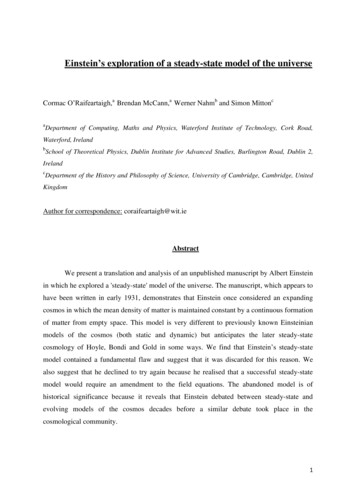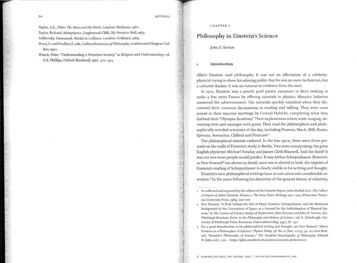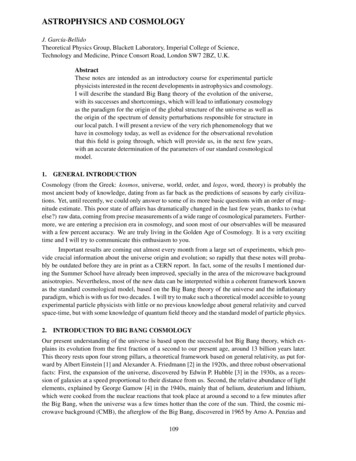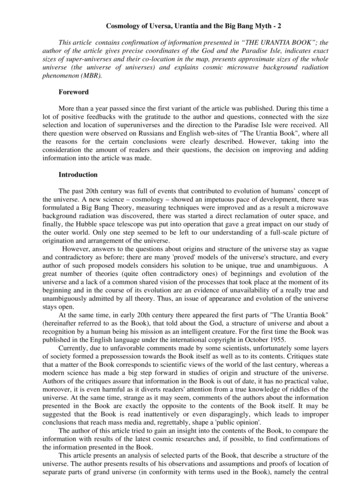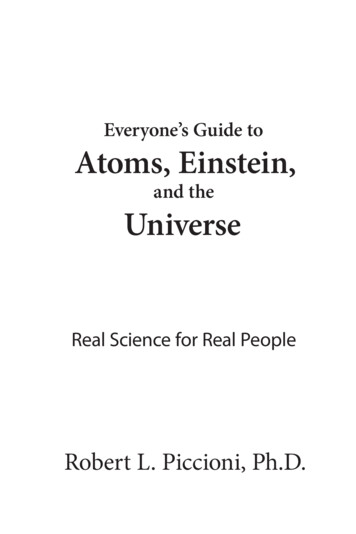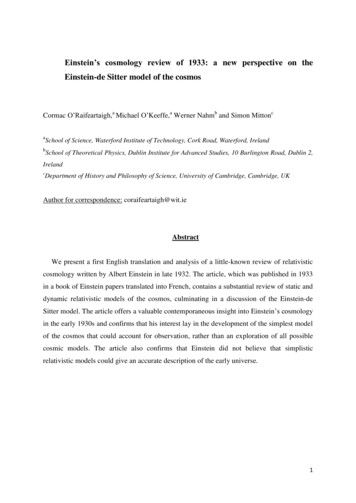
Transcription
Einstein’s cosmology review of 1933: a new perspective on theEinstein-de Sitter model of the cosmosCormac O’Raifeartaigh,a Michael O’Keeffe,a Werner Nahmb and Simon MittoncaSchool of Science, Waterford Institute of Technology, Cork Road, Waterford, IrelandbSchool of Theoretical Physics, Dublin Institute for Advanced Studies, 10 Burlington Road, Dublin 2,IrelandcDepartment of History and Philosophy of Science, University of Cambridge, Cambridge, UKAuthor for correspondence: coraifeartaigh@wit.ieAbstractWe present a first English translation and analysis of a little-known review of relativisticcosmology written by Albert Einstein in late 1932. The article, which was published in 1933in a book of Einstein papers translated into French, contains a substantial review of static anddynamic relativistic models of the cosmos, culminating in a discussion of the Einstein-deSitter model. The article offers a valuable contemporaneous insight into Einstein’s cosmologyin the early 1930s and confirms that his interest lay in the development of the simplest modelof the cosmos that could account for observation, rather than an exploration of all possiblecosmic models. The article also confirms that Einstein did not believe that simplisticrelativistic models could give an accurate description of the early universe.1
1. IntroductionWe recently came across a virtually unknown article written by Albert Einstein in late1932 that contains a comprehensive review of static and dynamic relativistic models of thecosmos, culminating in a discussion of the Einstein-de Sitter model. The article, a signed,twelve-page handwritten manuscript titled “Über das sogenannte kosmologische Problem”(“On the so-called cosmological problem”), was found listed as document [1-115] on theEinstein Online Archive of the Hebrew University of Jerusalem (Einstein 1932a). It is ourview that the document (figure 1) sheds useful light on Einstein’s cosmology in the 1930sand on the Einstein-de Sitter model in particular.According to the Albert Einstein Archive, manuscript [1-115] was sent by Einstein to hiscolleague Walther Mayer in early September 1932. Einstein collaborated closely with theyoung mathematician Mayer in the period 1930 to 1933 (Pais 1982 p492-493; Clark 1973 p386, 391; Michelmore 1962 p161, 184) and they published many papers together on topicssuch as unified field theory (Einstein and Mayer 1930, 1931, 1932a), mathematics (Einsteinand Mayer 1932b, 1934) and quantum mechanics (Einstein and Mayer 1933a, 1933b).1 It islikely that the manuscript was sent to Mayer for review; indeed, one technical passage is inMayer’s handwriting, as discussed below.Although Einstein’s article was never published in a scientific journal, we have discoveredthat it was published in a little-known book of three Einstein papers translated into French byEinstein’s lifelong friend and colleague Maurice Solovine. The article appeared under thetitle ‘Sur la Structure Cosmologique de l’Espace’ in the book ‘Les Fondaments de la Théoriede la Relativité Générale’ 2 published by Hermann in 1933 (figures 2 and 3). Correspondencebetween Einstein and Solovine in June 1932 indicates that the article was written specificallyfor the French book: “I’m not sure which works you refer to .but I could include a shorttreatise on my current approach to the cosmological problem” (Einstein 1932b).3 Einstein’smanuscript was duly sent to Solovine on September 29th, 1932. An accompanying letterindicates that Einstein found his “short treatise” more substantial than expected, and intendedto submit the work to a journal: “You impatient scoundrel! I managed to tie the thing1The collaboration was so fruitful that, when negotiating his position at the Institute of Advanced Studies atPrinceton, Einstein requested that a position also be found for Mayer (Pais 1982, p492-493; Isaacson 2007p397).2The book was one of a series of monographs by distinguished scientists published by Hermann et Cie, anacademic publishing house in Paris. The editorial board included Paul Langevin and Marie Curie, scientistsadmired by Einstein. The other two papers in the book were a translation of a classic paper on general relativity(Einstein 1916) and a translation of a paper on unified field theory (Einstein and Mayer 1931b).3We thank Barbara Wolff of the Albert Einstein Archive for communicating this letter to us.2
together only after putting myself to a great deal of trouble and going through muchreshuffling and some real work. But now it is crystal clear. I hope you will like it. However, Ireserve the right to incorporate it later into an English publication that I have beenpromising for two years .Please return the manuscript after you have finished thetranslation” (Einstein 1932c). In another letter a month later, Einstein proposed an alternativetitle for the article: “I believe that we can change the title to “On the Structure of Space onthe Largest Scales” (Einstein 1932d).We note that the promised “English publication” never appeared. It is likely thatEinstein intended to publish the article in the Monthly Notices of the Royal AstronomicalSociety, given his friendship with Arthur Eddington (Vibert Douglas 1956, p100-102; Clark1973 p398, Nussbaumer and Bieri 2009 p144) and given Eddington’s role as papers secretaryfor the Royal Astronomical Society.4 However, the paper did not appear in the MonthlyNotices, or any other science journal, perhaps because the closing months of 1932represented a time of great upheaval in Einstein’s life.5 Instead, the article was published onlyin a French booklet that did not enjoy a wide distribution,6 and it was effectively lost toposterity.7We present some historical remarks concerning Einstein’s cosmology and the Einstein-deSitter model in section 2 of this paper, followed by a guided tour of Einstein’s article insection 3. As the document was published in 1933 (in French), we shall henceforth refer to itas Einstein’s 1933 article (see Einstein 1933). We discuss the new insights offered by thearticle into the Einstein-de Sitter model in section 4, and conclude with some general remarkson Einstein’s cosmology in these years in section 5. An English translation of the full text ofEinstein’s article is presented in an Appendix by kind permission of the Hebrew University ofJerusalem. Our translation is taken directly from Einstein’s original handwritten manuscriptin German (document [1-115] on the Einstein Online Archive); we have not found any pointsof disagreement with the French translation by Solovine. One page missing from Einstein’soriginal manuscript is taken directly from the Solovine translation, as described in theAppendix.4Eddington regularly sought submissions for the Monthly Notices from outstanding international figures. Themost famous example was the republication of Lemaître’s seminal 1927 paper in English (Lemaître 1931).5With the victory of the National Socialists in the Reichstag in July 1932, Einstein’s position in Germanybecame very uncertain (Clark 1973 p420; Michelmore 1962 p172-174; Pais 1994, p187; Isaacson, 396-399).6Only a small number of copies of the book were issued and it soon went out of print.7We are unaware of a single citation of the article during Einstein’s lifetime and have found only two citationsin historical reviews of cosmology (Kerzsberg 1989, p361-362; Eisenstaedt 1993, p106-107).3
1. Historical context of the Einstein-de Sitter modelBy the early 1930s, it had been established that the only static models of the cosmosallowed by general relativity (Einstein 1917; de Sitter 1917) presented some problems of atheoretical nature. De Sitter’s empty universe was not truly static (Weyl 1923; Lemaître1925), while Einstein’s matter-filled universe was not stable (Lemaître 1927; Eddington1930).8 With Hubble’s discovery of a linear relation between the recession of the galaxiesand their radial distance (Hubble 1929), attention turned to the time-varying relativisticmodels of the cosmos that had been proposed independently by Alexander Friedman andGeorges Lemaître in the 1920s (Friedman 1922; Lemaître 1927). A variety of cosmic modelsof the Friedman-Lemaître type were advanced in the early 1930s to describe Hubble’sobservations in terms of a relativistic expansion of space (Eddington 1930, 1931: de Sitter1930a, 1930b; Tolman 1930a, 1930b, 1931, 1932; Heckmann 1931, 1932; Robertson 1932,1933).9 Einstein himself overcame his earlier distrust of time-varying models of the cosmos10and proposed two dynamic models during this period, the Friedman-Einstein model of 1931and the Einstein-de Sitter model of 1932 (Einstein 1931a; Einstein and de Sitter 1932).The Friedman-Einstein model (Einstein 1931a) marked the first paper in whichEinstein formally abandoned his static model. Citing Hubble’s observations, he took the viewthat his earlier assumption of a static universe was no longer justified:“Now that it hasbecome clear from Hubbel’s [sic] results that the extra-galactic nebulae are uniformlydistributed throughout space and are in dilatory motion (at least if their systematic redshiftsare to be interpreted as Doppler effects), assumption (2) concerning the static nature ofspace has no longer any justification.” (Einstein 1931a).11 Adopting Friedman’s 1922analysis of a universe of time-varying radius and positive spatial curvature,12 Einstein alsoabandoned the cosmological constant he had introduced in 1917, on the grounds that it wasnow both unsatisfactory (it gave an unstable solution) and unnecessary: “Under thesecircumstances, one must ask whether one can account for the facts without the introductionof the λ-term, which is in any case theoretically unsatisfactory” (Einstein 1931a). The8See (Kerzberg 1989 p327-335) or (Smeenk 2015) for a review of the problems associated with the staticmodels of Einstein and de Sitter.9Most of these models assumed a positive curvature of space, following Friedman’s analysis of 1922 andLemaître’s analysis of 1927.10Einstein described Friedman’s solution as “hardly of physical significance” in 1923, and dismissedLemaître’s model as “abominable’”in 1927. See (Nussbaumer and Bieri 2009 p 92,111) or (Nussbaumer 2014a)for a review of Einstein’s objection to dynamic models.11We have recently given a first English translation of this paper in (O’Raifeartaigh and McCann 2014).12Friedman’s analysis included a cosmological constant (Friedman 1922).4
resulting model predicted a cosmos that would undergo an expansion followed by acontraction, and Einstein made use of Hubble’s observations to extract estimates for thecurrent radius of the universe, the mean density of matter and the timespan of theexpansion.13In early 1932, Einstein and Willem de Sitter both spent time at Caltech in Pasadena,and they used the occasion to explore a new dynamic model of the cosmos (figure 4).Thismodel took as starting point an observation by Otto Heckmann that the presence of a finitedensity of matter in a non-static universe did not necessarily imply a positive curvature ofspace - the curvature could also be negative or even zero (Heckmann 1931).14 Mindful of alack of empirical evidence for spatial curvature, Einstein and de Sitter set this parameter tozero: “Dr O. Heckmann has pointed out that the non-static solutions of the field equations ofthe general theory of relativity with constant density do not necessarily imply a positivecurvature of three-dimensional space, but that this curvature may also be negative or zero.There is no direct observational evidence for the curvature, the only directly observed databeing the mean density and the expansion and the question arises whether it is possible torepresent the observed facts without introducing a curvature at all” (Einstein and de Sitter1932). With both the cosmological constant and spatial curvature removed, the resultingmodel described a cosmos of flat geometry in which the rate of expansion ℎ was related tothe mean density of matter 𝜌 by the simple relation ℎ2 13𝜅𝜌, with 𝜅 as the Einsteinconstant.15 Applying Hubble’s value of 500 km s-1 Mpc-1 for the recession rate of the galaxiesto their model, the authors found that it predicted a value of 4x10-28 g cm-3 for the meandensity of matter in the cosmos, a prediction they suggested was not incompatible withestimates from astronomy: “Although, therefore, the density corresponding to theassumption of zero curvature may perhaps be on the high side, it certainly is of the correctorder of magnitude, and we must conclude that at the present time it is possible to representthe facts without assuming a curvature of three-dimensional space” (Einstein and de Sitter1932).The Einstein-de Sitter model became very well-known and it played a significant rolein the development of 20th century cosmology. One reason was that it marked an important13We have recently suggested that these calculations contained some anomalies. We have also suggested thatthe model is not cyclic, as often stated (O’Raifeartaigh and McCann 2014).14The possibility of negative curvature was explored by Alexander Friedman in 1924 (Friedman 1924) but thiswork was not widely cited for many years. Ironically, Friedman did not specifically consider the possibility ofzero curvature in any of his works.15Here the Einstein constant 𝜅 was taken as 8𝜋𝐺 𝑐 4 . The pressure of radiation was also assumed to be zero.5
hypothetical case in which the expansion of the universe was precisely balanced by a criticaldensity of matter; a cosmos of lower mass density would be of hyperbolic spatial geometryand expand at an ever increasing rate, while a cosmos of higher mass density would be ofspherical geometry and eventually collapse. Another reason was the model’s great simplicity;in the absence of any observational evidence for spatial curvature or a cosmological constant,there was little reason to turn to more complicated models.16 Indeed, the theory remained afavoured model of the universe for many years (North 1965 p134; Kragh 1996 p35;Nussbaumer and Bieri 2009 p 152; Nussbaumer 2014a), although it soon emerged thatneither the predicted timespan of the expansion (see below) nor the required density of matterwere in good agreement with observation.17However, it is a curious fact that, while a detailed exposition of the Einstein-de Sittermodel can be found in any modern textbook on cosmology, the paper published by Einsteinand de Sitter in 1932 was an extremely terse affair. Noting that the only directly observabledata were the mean density of matter and the expansion of the cosmos (see first quote above),the authors did not fully develop the model in the paper, but confined their interest toestablishing a relation between these two parameters. Indeed, this approach is evident in thetitle of the paper –“On the Relation between the Expansion and the Mean Density of theUniverse” (Einstein and de Sitter 1932). For example, the authors did not describe the timeevolution of the expansion, an important aspect of any dynamic model of the cosmos. Thisomission was unfortunate, because the timespan of expansion implicit in the model was infact problematic in comparison with estimates of the age of the earth from radioactivity, orestimates of the age of the stars from astrophysics (Kragh 1996 p 73-74: Nussbaumer andBieri 2009 pp 153-155). The authors also passed over more general issues associated with themodel, notably the puzzle of a matter-filled universe of infinite space,18 and the problem ofan implied beginning for spacetime.19 Thus, it has often been noted that the Einstein-de Sitterpaper of 1932 was a rather slight work (Kragh 1996 p35; Kragh 2007 p 156; Nussbaumer and16Solid evidence for a positive cosmological constant did not emerge until 1992, while no evidence for spatialcurvature has yet been detected.17Astronomical observations measurements from 1932 onwards suggested a mean density of matter far belowthe critical value required by the Einstein-deSitter model (Oort J. 1932; Zwicky, F. 1933, 1937; Mitton 1976 pp168-177).18For example, Lemaître dismissed the possibility of a dynamic cosmos of Euclidean geometry in 1925 due to“the impossibility of filling up an infinite space with matter which cannot but be finite” (Lemaître 1925).19The related question of an origin for the universe had been raised almost a year before (Lemaître1931b,1931c).6
Bieri 2009, pp150-152; Nussbaumer 2014a)20and it has even been suggested that the paperwould hardly have been published had it been written by less illustrious authors (Nussbaumerand Bieri 2009, p150; Barrow 2011 p75).21 We were therefore delighted to find a little-knownreview of relativistic cosmology written by Einstein later that same year, containing adetailed exposition of the Einstein de Sitter model.2. A guided tour of Einstein’s 1933 article22Einstein begins his cosmology review by comparing the relativistic and pre-relativisticviews of space and time. He points out that, in the non-relativistic case, space and time areseen as ‘absolute’ in the sense of a reference frame that has a tangible physical reality:“When we call space and time in pre-relativistic physics “absolute”, it hasthe following meaning. In the first instance, space and time, or the frame ofreference, signify a reality in the same sense as, say, mass. Co-ordinatesdefined with respect to the chosen reference frame are immediatelyunderstood as results of measurement. Propositions of geometry andkinematics are therefore understood as relations between measurements thathave the significance of physical assertions which can be true or false. Theinertial reference frame is understood to be a reality because its choice isinherent in the law of inertia.”Einstein then points out that space and time are viewed as ‘absolute’ in a second sense innon-relativistic physics, i.e., in the sense that they are not influenced the behaviour ofmaterial bodies:“Secondly, in terms of the laws obeyed, the physical reality denoted by thewords space and time is independent of the behaviour of the rest of thephysically real world, that is, independent of material bodies for example.According to classical theory, all relationships between measurements,which can themselves only be obtained using rulers and clocks, areindependent of the distribution and motion of matter; the same is true for the20Heckmann, who considered the case of zero curvature as one of many possible models in 1931 and 1932(Heckmann 1931, 1932), described the Einstein-de Sitter paper was “not very profound” (Heckmann 1976, p28).21A well-known story by Eddington suggests that the authors themselves did not attach too much importance tothe work at the time (Eddington 1940, p128; Plaskett 1933; Nussbaumer and Bieri 2009 p152).22We suggest Einstein’s article be read in full (Appendix) before reading this section.7
inertial reference frame. Space enables the physical, in a sense, but cannotbe influenced by the physical.”Einstein opines that this view is not untenable, but it divides nature into an a priori realityand a secondary reality:“Such a theory is by no means logically untenable, although it isunsatisfactory from an epistemological point of view. In it, space and timeplay the role of an a priori reality, as it were, different from the reality ofmaterial bodies (and fields) which appear to some extent as a secondaryreality.”He then points out that the general theory of relativity does not impose this division, citingthis as a major achievement of relativity:“It is precisely this unsatisfactory division of physical reality that thegeneral theory of relativity avoids. From a systematic point of view, theavoidance of this division of physical reality into two types is the mainachievement of the general theory of relativity.”Einstein notes that another achievement of the general theory, namely that gravity and inertiacan be described in a single framework:“The latter also made it possible to comprehend gravity and inertia from acommon perspective. In view of the above, the use of general Gaussian coordinates, which provide a continuous labelling of points in space-timewithout reference to metric relations, is a mere (albeit indispensable) tool thatallows the metric properties of the continuum to be coordinated with its otherproperties (gravitational field, electromagnetic field, law of motion).”We note that in this interpretation, spacetime does not have an independent existence beyondgiving expression to the relations among physical processes in the universe (see section 4).However, the new theory poses a puzzle not found in classical physics, namely the effect of anon-zero mean density of matter on the metric of spacetime, a puzzle Einstein names the “socalled cosmological problem”:“Since, according to the general theory of relativity, the metric properties ofspace are not given in themselves but are instead determined by materialobjects that force a non-Euclidean character on the continuum, a problemarises that is absent from the classical theory. Namely, since we may assumethat the stars are distributed with a finite density everywhere in the world,that is, a non-zero average density of matter in general, there arises thequestion of the influence of this mean density on the (metric) structure of8
space on a large scale; this is the so-called cosmological problem that wewish to address in this short note.”To tackle the problem, Einstein first recalls the problem of gravitational collapse in aNewtonian universe, and a proposed solution by Hugo von Seeliger:“Moreover, the assumption of a finite non-zero mean density of matter alreadyleads to difficulties from the point of view of the Newtonian theory, as theastronomers have long known. Namely, according to the theorem of Gauss, thenumber of lines of gravitational force that cross a closed surface from the outsideto the inside is equal to a constant multiple of the gravitating mass enclosed bythe surface. If this matter has the constant density ρ, then for a sphere of radiusP, the number of lines of force is proportional to P3. Therefore the flux of forceper unit area of the sphere is proportional to the radius of the sphere, and so thegreater the radius of the sphere, the greater it will be. Hence, according toNewton’s theory, free matter of a finite constant density cannot remain in globalequilibrium. To avoid the resulting difficulty, the astronomer Seeliger proposed amodification of the Newtonian law of attraction for large distances. Of course,this question had nothing to do with the problem of space.”23Einstein then restates the problem for the case of general relativity:“The corresponding problem in the general theory of relativity leads to thequestion: how is it possible to have a space with a spatially constant density ofmatter that is at rest relative to it? Such a space shall be dealt with as the crudestidealization for a theoretical comprehension of the actual space-time-continuum.”Einstein begins his analysis of the cosmological problem by recalling the fieldequations of general relativity:“According to the general theory of relativity, the metric or gravitational fielddescribed by the 𝑔𝜇𝜈 is related to the energy or mass density tensor 𝑇𝜇𝜈 by theequation𝑅𝜇𝜈 1𝑔 𝑅 𝜅 𝑇𝜇𝜈2 𝜇𝜈 (1)23In order to avoid the problem of gravitational collapse in the Newtonian universe, Hugo von Seeligersuggested the introduction of an extra term to Newton’s law of gravitation that would be effective only at thelargest distances (Seeliger 1895, 1898). Einstein referred to Seeliger’s solution in the third edition of his popularbook on relativity (Einstein 1918 pp71-72) and in 1919, he stated that he would have cited Seeliger’s solution inhis cosmological model of 1917 had it been known to him at the time (Einstein 1919a).9
Here 𝑅𝜇𝜈 signifies the once-contracted Riemann tensor𝛽𝛽𝛼𝛼𝛼𝛼𝑅𝜇𝜈 𝛤𝜇𝜈,𝛼 𝛤𝜇𝛼,𝜈 𝛤𝜇𝛽𝛤𝜈𝛼 𝛤𝜇𝜈𝛤𝛼𝛽 .1(a)Making the assumption that influences such as the pressure of matter and radiation can beignored, he constructs the stress-energy tensor in the usual manner:“If “matter” can be idealised as pressure-free, and the influence of effects otherthan gravity can be neglected, then𝑇𝜇𝜈 𝜌𝑢𝜇 𝑢𝜈 (2)where 𝑢𝜇 denotes the contravariant four-dimensional velocity vector𝑑𝑋𝜇𝑑𝜏and ρthe scalar density of matter. Naturally, it is also assumed that the energy densityof the ponderable matter outweighs that of the radiation to the extent that thelatter can be neglected. Although the validity of this assumption is not entirelyassured, the approximation introduced does not essentially alter the results.”Einstein first considers the simplest of all spacetime geometries, the static, flat spacetimeof Minkowski, and notes that it is not compatible with a universe with a non-zero densityof matter:“One sees first of all that a world with a non-zero density of matter cannot beeuclidean. For such a world is given in terms of the special theory of relativity bya line element𝑔𝜇𝜈 𝑑𝑥 𝜇 𝑑𝑥 𝜈 𝑑𝑠 2 𝑑𝑥12 𝑑𝑥22 𝑑𝑥32 𝑐 2 𝑑𝑡 2 (3)i.e., by constant values for the 𝑔𝜇𝜈 . 𝑅𝜇𝜈 and 𝑅 then vanish and with them the leftside of (1). It follows that the right-hand side of (1) must also vanish, and with it𝜌, in contradiction to our assumption.”Einstein then considers the next simplest metric, a static spacetime of constant curvature:“After euclidean space, the simplest spatial structure conceivable would seem tobe one that is static (all 𝑔𝜇𝜈 independent of 𝑡) and that has constant curvaturewith respect to the “spatial” sections (𝑡 constant). As is well known, a threedimensional space with constant positive curvature (in particular a “spherical”space) is characterised by the line element 𝑑𝜎 2 of the form:10
𝑑𝜎 2 𝑑𝑥12 𝑑𝑥22 𝑑𝑥32( 𝑟 2 𝑥21 𝑥22 𝑥23 )2𝑟2(1 )2(2𝑃)where the point 𝑥1 𝑥2 𝑥3 0 is only apparently singled out. A world thatis static and spatially spherical is therefore described by the line element:𝑑𝑠 2 𝑑𝑥12 𝑑𝑥22 𝑑𝑥322𝑟2(1 )(2𝑃)2 𝑐 2 𝑑𝑡 2 (3𝑎)” 24With the use of this metric, Einstein calculates values for 𝑅𝜇𝜈 12𝑔𝜇𝜈 𝑅 and the stress-energy tensor 𝑇𝜇𝜈 , and derives two mutually contradictory differential equations:“Thus, from (1) the two contradictory equations are obtained:1 0𝑃23𝑐 2𝑃2 𝜅𝜌𝑐 2(4)Therefore equations (1) do not allow the possibility of a non-zero uniformdensity of matter ρ. This immediately creates a serious difficulty for thegeneral theory of relativity, given that time-independent spatial structuresother than those given by (3a) (for positive or negative 𝑃2 ) areinconceivable.”Einstein then recalls his 1917 solution to this problem, namely, the introduction of thecosmological constant to the field equations:“I initially found the following way out of this difficulty. The requirements ofrelativity permit and suggest the addition of a term of the form 𝜆𝑔𝜇𝜈 to theleft hand side of (1), where 𝜆 denotes a universal constant (cosmologicalconstant) which must be small enough that the additional term need not beconsidered in practice when calculating the sun’s gravitational field and themotion of the planets. Completed in this manner, the equations are( 𝑅𝜇𝜈 1𝑔 𝑅 )2 𝜇𝜈 𝜆𝑔𝜇𝜈 𝜅 𝑇𝜇𝜈 . (1𝑏)Instead of equations (4) one then finds:24We have obtained equation 3(a) and the sentence preceding it from the Solovine translation (Einstein 1933),as the passage containing this equation and the tensor calculations that follow is missing from manuscript [1115] (see Appendix).11
1𝑃23𝑐2𝑃2 𝜆 𝜆𝑐2 𝜅𝜌𝑐2} (4𝑎)These equations are consistent and yield the following value for the worldradius:𝑃 2 𝜅𝜌 𝑐 2𝜋К𝜌(5)where К denotes the gravitational constant as measured in the usual systemof measurement.”Einstein then points out that this solution was subsequently found to be unstable, citingthe work of Friedman and Lemaître:25“However, it later emerged as a result of research by Lemaitre andFriedmann that this resolution of the difficulty is unsatisfactory for thefollowing reason. The above-mentioned authors generalized the approach(3a) by introducing the world radius P (and the density ρ) not as a constant,but rather as an a priori unknown function of time. Equations (1b) then showthat solution (4a),(5) has an unstable character.”Addressing the new time-dependent models, Einstein first notes that the magnitude and signof the cosmological constant are no longer determined, nor is the sign of spatial curvature:“Furthermore, if one adopts these “dynamic” solutions then both themagnitude and the sign of λ will remain undetermined, and indeed even the1sign of 𝑃2 , so that negative spatial curvatures also appear possible and thusthe basis for the postulate of a spatially closed world is completelyremoved.”At this point, Einstein cites Otto Heckmann as the first to suggest the possibility of negativespatial curvature (see appendix).26 We note that Einstein is still apparently unaware thatFriedman explored the possibility of negative spatial curvature many years before (Friedman25This is the first time that Einstein cites Lemaître’s dynamic model in a scientific paper.Einstein does not give a specific reference for Heckmann’s work. It is likely that he is referring toHeckmann’s cosmology paper of 1931 (Heckmann 1931), rather than Heckmann’s more comprehensive paperof 1932 (Heckmann 1932) as Einstein’s review was written in late 1932.2612
1924). Before addressing the issue of curvature further, Einstein suggests that the dynamicmodels have rendered the cosmological constant redundant:“Given that the theory leads us to adopt dynamic solutions for the structureof space, it is no longer necessary to introduce the universal constant λ, asthere are dynamic solutions for (1) of type (3a) for which 𝜆 0. “In the next paragraph, Einstein turns to observation, providing a succinctsummary of the discovery by astronomers of a velocity/distance relation for the spiralnebulae. He notes that the astronomical observations gave a new impetus to dynamiccosmologies, and offered support for the assumption of cosmic homogene
1 Einstein’s cosmology review of 1933: a new perspective on the Einstein-de Sitter model of the cosmos Cormac O’Raifeartaigh,a Michael O’Keeffe,a Werner Nahmb and Simon Mittonc aSchool of Science, Waterford Institute of Technology, Cork Road, Waterford, Ireland bSchool of Theoretical Physics, Dublin Institute for Advanced Studies, 10 Burlington Road, Dublin 2,Cited by: 6Publish Year: 2015Author: Cormac O’Raifeartaigh, Michael O’



